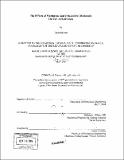| dc.contributor.advisor | Richard J. Gilbert. | en_US |
| dc.contributor.author | Shearer, David, 1982- | en_US |
| dc.contributor.other | Massachusetts Institute of Technology. Dept. of Mechanical Engineering. | en_US |
| dc.date.accessioned | 2006-05-15T20:29:58Z | |
| dc.date.available | 2006-05-15T20:29:58Z | |
| dc.date.copyright | 2004 | en_US |
| dc.date.issued | 2004 | en_US |
| dc.identifier.uri | http://hdl.handle.net/1721.1/32785 | |
| dc.description | Thesis (S.B.)--Massachusetts Institute of Technology, Dept. of Mechanical Engineering, 2004. | en_US |
| dc.description | Includes bibliographical references (leaves 28-29). | en_US |
| dc.description.abstract | The cytoskeleton, the internal network of filaments that regulates cell shape and structure, has been implicated in several critical aspects of cell adhesion. Its role, however, has primarily been demonstrated as a component of the numerous intracellular signaling events that regulate cell surface receptors. In this study we sought to gain insight into how the mechanical properties of the cytoskeleton could affect adhesion. Specifically, we addressed how membrane deformability, which we demonstrate is critically dependent upon tethering to the cytoskeleton, could impact a whole cell adhesion assay. To modify membrane deformability, we treated cells with the pharmacological agents phalloidin, Latrinculin B, Cytochalasin D, colchicine, and Paclitaxel, which have varying effects on microfilaments and microtubules, two of the main constituents of the cytoskeleton. We found that dissolution of the actin cytoskeleton could reduce the number of adherent cells to a callogen-coated substrate by over 85%. We theorize that this is due largely to the inhibition of signaling events associated with the cytoskeleton, but it may also be affected by changes in shape and deformability. To truly understand the implications of this experiment, we believe further study using high-resolution force technology such as atomic force microscopy or magnetic bead microrheometry is necessary. | en_US |
| dc.description.statementofresponsibility | by David Shearer. | en_US |
| dc.format.extent | 29 leaves | en_US |
| dc.format.extent | 1507256 bytes | |
| dc.format.extent | 1505937 bytes | |
| dc.format.mimetype | application/pdf | |
| dc.format.mimetype | application/pdf | |
| dc.language.iso | eng | en_US |
| dc.publisher | Massachusetts Institute of Technology | en_US |
| dc.rights | M.I.T. theses are protected by copyright. They may be viewed from this source for any purpose, but reproduction or distribution in any format is prohibited without written permission. See provided URL for inquiries about permission. | en_US |
| dc.rights.uri | http://dspace.mit.edu/handle/1721.1/7582 | |
| dc.subject | Mechanical Engineering. | en_US |
| dc.title | The effects of membrane and cytoskeletal mechanics on cell adhesiveness | en_US |
| dc.type | Thesis | en_US |
| dc.description.degree | S.B. | en_US |
| dc.contributor.department | Massachusetts Institute of Technology. Department of Mechanical Engineering | |
| dc.identifier.oclc | 57582935 | en_US |
